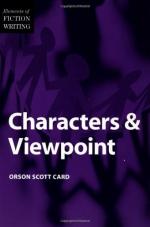
|
| Name: _________________________ | Period: ___________________ |
This test consists of 15 multiple choice questions and 5 short answer questions.
Multiple Choice Questions
1. Which of the following is not an example of a minor character's function?
(a) To act as a love interest.
(b) To create suspense.
(c) To offer information.
(d) To define the main theme.
2. How does the author describe writing based on an issue?
(a) A tricky source of characters.
(b) An ambiguous source of characters.
(c) A misleading source of characters.
(d) A distracting source of characters.
3. On a basic level, which one of the following defines character in a narrative?
(a) Relationships with milieu, but not idea.
(b) Relationships with idea, but not milieu.
(c) Relationships with milieu and idea.
(d) Relationships with all forms except for milieu and idea.
4. What does the writer use with words to achieve his/her main goals?
(a) Research.
(b) Poetic license.
(c) Grammar.
(d) Structure.
5. What two ideals is the author blending in Chapter 9?
(a) The selfish with the unselfish.
(b) The predictable with the unpredictable.
(c) The intelligent with the unintelligent.
(d) The romantic with the realistic.
6. What kind of story does the author use as an example of how a story can suggest characters?
(a) Unwilling confinement.
(b) Murder.
(c) Space adventure.
(d) Natural disaster.
7. In defining a fictional character, what causes people to behave differently?
(a) Their education.
(b) Their age.
(c) The society they live in.
(d) The network they are in.
8. In an event-driven narrative, what is the goal of the characters?
(a) To hide an intolerable situation.
(b) To prevent an intolerable situation.
(c) To avoid an intolerable situation.
(d) To change an intolerable situation.
9. What can other characters provide for the main character?
(a) Assistance, but never conflict.
(b) Neither conflict nor assistance.
(c) Conflict or assistance.
(d) Conflict, but never assistance.
10. How well do readers want to know characters in a book?
(a) As well as they know people in a movie.
(b) Better than they know characters in a movie.
(c) As well as they know people in life.
(d) Better than they know people in life.
11. What do the readers and creators of a contemporary narrative believe about in-depth characterization?
(a) It is expected, but not necessary.
(b) It is both expected and necessary.
(c) It is necessary, but not expected.
(d) It is neither expected nor necessary.
12. What will help a writer to maintain consistency?
(a) Not having more than three central characters.
(b) Not having more than four supporting characters.
(c) Keeping a list of character traits and facts.
(d) Keeping a list of character names.
13. What type of imperfections can be appealing to readers?
(a) Endearing.
(b) Unknown.
(c) Uncontrollable.
(d) Temporary.
14. How necessary is it for characters to be more than stereotypes in a narrative where an idea is the primary focus?
(a) Somewhat necessary.
(b) The characters are never more than stereotypes in a narrative.
(c) Very necessary.
(d) Rarely necessary.
15. What should the writer's own experiences have in order to be used as fictional inspiration?
(a) Theoretical, spiritual, or experiential connection with a character.
(b) Emotional, spiritual, or experiential connection with a character.
(c) Emotional, theoretical, or spiritual connection with a character.
(d) Emotional, theoretical, or experiential connection with a character.
Short Answer Questions
1. What kind of jeopardy can a character be placed in to evoke an emotional response from the reader?
2. With what does the author intend to help writers?
3. What kinds of situations can make a character more interesting?
4. What type of reaction will an audience have to a character with opposing characteristics?
5. What is the author's theory about fiction in Chapter 5?
|
This section contains 638 words (approx. 3 pages at 300 words per page) |

|




